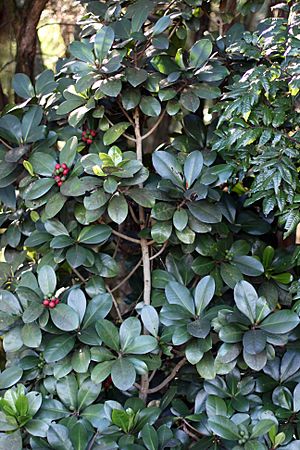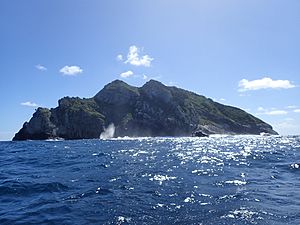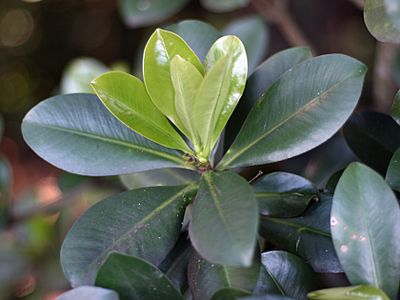Elingamita facts for kids
Quick facts for kids Elingamita |
|
|---|---|
 |
|
| Conservation status | |
| Scientific classification | |
| Genus: |
Elingamita
|
| Species: |
johnsonii
|
Elingamita johnsonii is a very special tree or shrub. It belongs to the plant family Primulaceae. You can only find this plant on the Three Kings Islands in New Zealand. These islands are about 55 kilometers (34 miles) north of New Zealand's North Island.
This tree is quite rare! All the wild Elingamita johnsonii trees in the world grow on just one small rocky island and two tiny islets nearby. This means they are easily harmed by things like fires or other unexpected problems.
Elingamita johnsonii grows as a shrub or small tree in forests with pohutukawa trees. It also grows in coastal scrub on West Island. You can also find it on two rocky islets called the Princes Group. On one of these islets, Hinemoa Rock, it grows as a tall tree that stands out above the other plants.
Scientists are still working to understand how Elingamita is related to other plants in the Primulaceae family. This tree was first discovered in 1950. Its name, Elingamita johnsonii, comes from a ship called the Elingamite. This ship was wrecked on West Island in 1902. The areas where the tree naturally grows do not have rodents (like rats). However, the tree's fruit is very tasty to rats, which could be a problem if rats ever get to the islands.
What Elingamita johnsonii Looks Like
Elingamita johnsonii is a strong tree that can grow up to 8 meters (about 26 feet) tall. But it is usually much shorter than that. Its bark is grey and smooth.
The leaves are dark green and shiny, like satin. They are quite large, about 10 to 18 centimeters (4 to 7 inches) long and 4 to 9 centimeters (1.5 to 3.5 inches) wide. The stems that hold the leaves are short, about 1 centimeter (less than half an inch) long.
The tree has tiny flowers that are pale yellow to pink. They grow in bunches at the ends of the branches. These flowers usually appear between February and May. Sometimes, they also bloom between August and November. Male and female flowers usually grow on different trees.
The tree produces attractive, grape-like bunches of red fruit. These fruits take a year or more to become ripe. Each fruit is round and about 20 millimeters (almost an inch) wide. Inside, there is a single seed.
The leaves of Elingamita johnsonii might look a bit like those of a Karaka tree (Corynocarpus laevigatus). However, the leaf stalks (petioles) of Elingamita johnsonii are much shorter. Also, its bunches of red, fleshy fruit are very easy to spot. You might see these fruits on the tree at any time of the year. The fruits are safe to eat. Their white flesh tastes a bit like a salty apple.
- Detailed views
How Elingamita johnsonii Grows and Reproduces
You can sometimes buy Elingamita johnsonii plants from special plant nurseries. It is quite easy to grow new plants from seeds. However, it might take a year for the seeds to sprout.
Once they sprout, the young plants grow quickly. They do best in places with some shade and soil that is rich and drains water well. After the plants are bigger and stronger, they can grow well in full sun. It is harder to grow new plants from cuttings (small pieces of the plant).
To get fruit, you need both a male and a female plant. This is because the male and female flowers grow on separate trees.
In gardens, Elingamita johnsonii makes a beautiful tree, especially in areas that do not get frost. This plant is very sensitive to cold weather and cannot handle frost at all.
See also
 In Spanish: Elingamita johnsonii para niños
In Spanish: Elingamita johnsonii para niños





